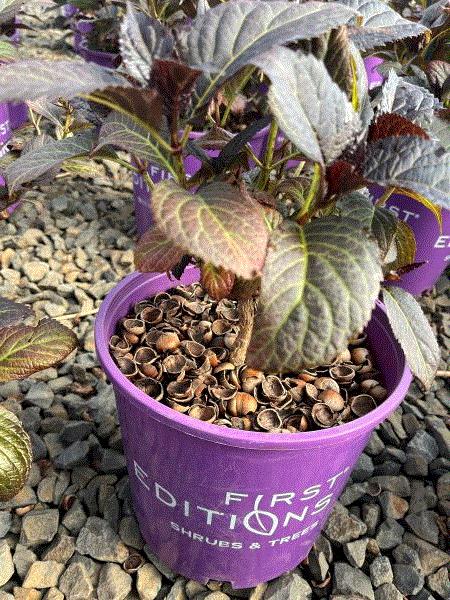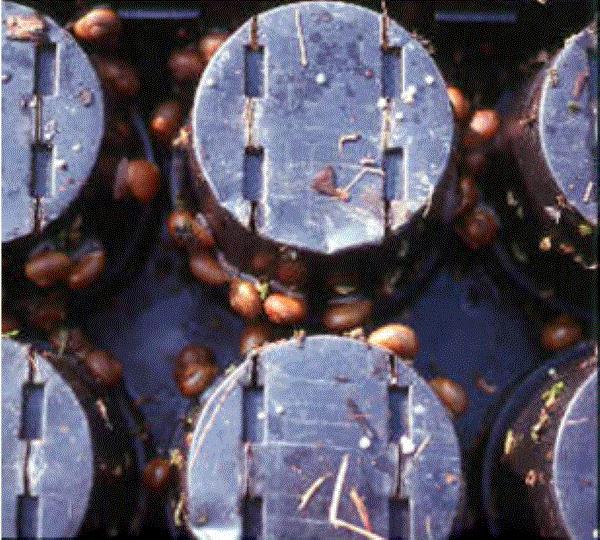What the ... ?
I’d been making the rounds in March and April. It’s interesting to see how erratic the spring weather was throughout the country. And here's what’s ironic about it: The sales of our spring crops depend so much on the weather! The rain and snow in the first week of April messed up shipping and sales in Michigan. But the super-nice weather in Colorado and Oregon in the second through the last week of April meant that folks ain’t having many problems with sales.
Y’all were so nice about meeting me and my colleagues at SePRO during this busy time. For that, I thank you!
I also saw something I’d never seen in a pot during my visit to Kraemer’s Nursery in Mount Agel, Oregon. No, no, not the hydrangea cultivars; I know where those come from. I meant those opened nut shells. What in the world are they? I can tell you the nursery doesn’t have a serious squirrel infestation.

This time, I won’t keep you in suspense until the end of this newsletter because the answer is related to today’s main topic.
Those were hazelnut shells. I thought it was a pretty sustainable way of using waste from another local horticultural commodity, similar to rice hulls.
Yes, like rice hulls, the hazelnut shells serve as a weed barrier, but they also double as a snail and slug barrier. A quick search on the web returned multiple sellers of hazelnut shell snail blockers and other ways to use nut shells, from making biochar and biosorbents, fueling power generation to mixing in concrete and livestock feed. Who knew?
Andy Liner of Kraemer explained that he decided to use half shells instead of crushed-up smaller pieces (which seems to be the size of most shell products) because larger pieces do better at stopping the slugs and snails. That makes sense to me. A “beach” of fine pieces of shells seems to be a smoother and easier surface for a snail to crawl over than the “lava field” created by a pile of large pieces. What an innovative approach to a common problem, or rather, problems.
It’s pretty cool to learn something new!

Snail & Slug Resources
Seeing how hazelnut shells are used as snail and slug blockers makes me want to review snail and slug management in today’s newsletter. Spring rains bring out the slimy crawly creatures.
Not everybody has to deal with snails and slugs (or mollusks). Folks in the Pacific Northwest, California and Hawaii are on the frontline of this battle, which has gone on for a good part of the last two decades. Snails and slugs can also be occasional problems for growers in Florida and other parts of the Southeast, or anywhere with plenty of moisture.
There are many terrestrial and semi-aquatic snail and slug species that can cause management, and even quarantine issues, for folks. The troublesome species may be the brown garden snail, amber snail, leopard slug, banded tree snail or other species, depending on where you are. Knowing your foes is half the battle, so here are a few resources I think may be helpful in identifying and managing these slimy pests.
First, let’s talk about resources for identification. Just like all other pests, you’ll need to properly identify what you're dealing with before you can decide what you should do.
Feeding by snails and slugs leaves holes in the foliage. But how do you know if the holes are indeed caused by snails and slugs instead of other defoliators, such as caterpillars, flea beetles or black vine weevils? This can be quite hard since the damage looks quite similar among these defoliators. Snails and slugs are more likely to cause damage on certain low-growing plants in moist, shaded areas. Finding the snails and slugs with a trap or their slime trails on mulch or leaf surfaces helps narrow down the suspects.
Now, damage to plants isn’t the only way snails and slugs can cause problems. Finding actionable or regulated invasive species on or under the pots and on the trees can cause rejection of a shipment.

Invasive slugs and snails hiding under pots, trays or on trees can mean big regulatory headaches. (Photo credit: Catharine Mannion, University of Florida.)
If you can catch snails and slugs in action or in a trap, you may be able to identify them. I introduced y’all to a website called California Nursery Pest Snails and Slugs—this website is no longer available. (Perhaps I just can’t find it; let me know if you know how.)
But I found another resource that can be useful in identifying terrestrial snails and slugs in California via iNaturalist. For folks in the Pacific Northwest, "Slugs and Snails in Oregon" published by the Oregon Department of Agriculture is very useful. Folks in Florida can identify some of the major species using the Florida Snail Identification Sheet from the Florida Department of Agriculture & Consumer Services.
The Oregon State University’s Slugs/Snails website, originally edited by Robin Rosetta, and the Slug Portal, developed by a team led by Rory Mc Donnell, contain great resources for identification, monitoring and management. The Snails and Slugs Management Guidelines from the University of California IPM Program also contains useful information.
Lastly, check out the recordings from a 2023 webinar on invasive snails and slugs, hosted by the Washington Invasive Species Council. You can learn about the basics of malacology (the scientific study of mollusks), several invasive slug and snail species in the Pacific Northwest, California and Florida, and their management.
There are other openly accessible publications or resources on identifying and managing snails and slugs. If you know or use one that I haven’t mentioned, let me know.

IPM for Slugs and Snails
How do you manage slugs and snails? I talked about this in the June 2023 issue of this newsletter. Just about all of what I mentioned in the 2023 issue, with the exception of hazelnut shells, is still valid today. I’ll summarize it again.
Water or moisture management is paramount to slug and snail management. Roughly 60% of human body weight is water; this number can only be higher in snails and slugs, for whom keeping body moisture can mean life or death. Moisture is even more important for species that are considered somewhat semi-aquatic, such as amber snails, which seems to be a bigger problem wherever it’s wet. Increasing plant spacing and using drip irrigation can also help with reducing moisture and/or shade. Keeping everything dry will make an area less suitable or preferable for amber snails and other species.
Another factor that determines the suitability of a habitat is the availability of food and shelter. Cleaning up debris, weeds and decaying plant materials, which many slug and snail species use for shelter and food sources, can go a long way in denying the pests suitable conditions for thriving. Strategically placed boards can mimic suitable habitats and serve as traps for some species. Pay more attention to monitoring or management on plant species or growth stages known to be highly preferred by snails and slugs.

Slugs and hosta, slugs and hosta, they go together in the shade and moisture ... Okay, I didn't ever say that I was a song writer of any capability. (Photo credit: University of Maryland Extension.)
Applying baits may be the best approach if reduction of the population is needed. Snail and slug baits contain metaldehyde, iron phosphate, sodium ferric EDTA or spinosad. The bait should be spread uniformly across the floor, instead of piling into mounds in the corners; spreading the bait out can maximize the chance that a snail or slug will come across and consume the bait. If y’all can irrigate before bait application, the higher moisture will get the slugs and snails moving and looking for food. But you want to withhold irrigation for a day after bait application so that the bait isn’t ruined or disrupted by the water.
There's no sprayable option for snail and slug management, as far as I know. The only product previously available (methiocarb or Mesurol) is no longer available.
Also, go HERE for a GrowerTalks article by Stanton Gill of the University of Maryland on managing slugs and snails in greenhouses.

Research Says ...
So how effective are the baits? As with many things IPM, I go to the IR-4 Environmental Horticulture database to find some first-hand data on efficacy. It just so happens that IR-4 published a research summary on the efficacy of various products against brown garden snail last week.
Between 2009 and 2020, Cheryl Wilen (University of California), Rory McDonnall (Oregon State University) and Buzz Uber (Crop Inspection Service) conducted several trials to investigate the efficacy of 11 products (containing eight active ingredients) against brown garden snails. Two baits containing metaldehyde (Deadline and Metarex) provided consistently good efficacy. Studies conducted by Catharine Mannion of the University of Florida also reported good efficacy of metaldehyde baits against Cuban land snail.
With Mesurol no longer available, sprayable products for snail and slug management are limited. A study on amber snail by Robin Rosetta of Oregon State University suggested good efficacy of Sevin, which was comparable in efficacy to Mesurol. (Sevin SL is not registered for snail and slug management. It’s registered for rose slug, but rose slug is a sawfly, not a slug. Another example of a misleading common name.) Although some baits contain spinosad, sprays of spinosad didn’t work well against brown garden snails.
Baits that contain iron phosphate, sodium ferric EDTA, spinosad and saponin had variable efficacy in the IR-4 trials. These baits generally didn’t cause high mortality of brown garden snails, but they reduced feeding damage in some trials. I would give these baits a try and see how well they reduce feeding in your operation, then you can decide if they're worth using.
Copper flashing is sometimes used to make a barrier for snails and slugs. A question is often raised about the potential of applying copper products to the surface of pots to serve as a barrier for snails and slugs. SpinOut, which contains copper hydroxide and is used as a root regulator, wasn't effective in killing brown garden snails, but it reduced feeding damage. (Disclaimer: SpinOut is a product of SePRO, the company I’m working for.) Currently, however, SpinOut isn’t registered for slug and snail management.
Good luck fighting off snails and slugs this spring!





See y'all next time!

JC Chong
Technical Development Manager at SePRO
Adjunct Professor at Clemson University
This e-mail received by 27,847 subscribers like you!
If you're interested in advertising on PestTalks contact Kim Brown ASAP!